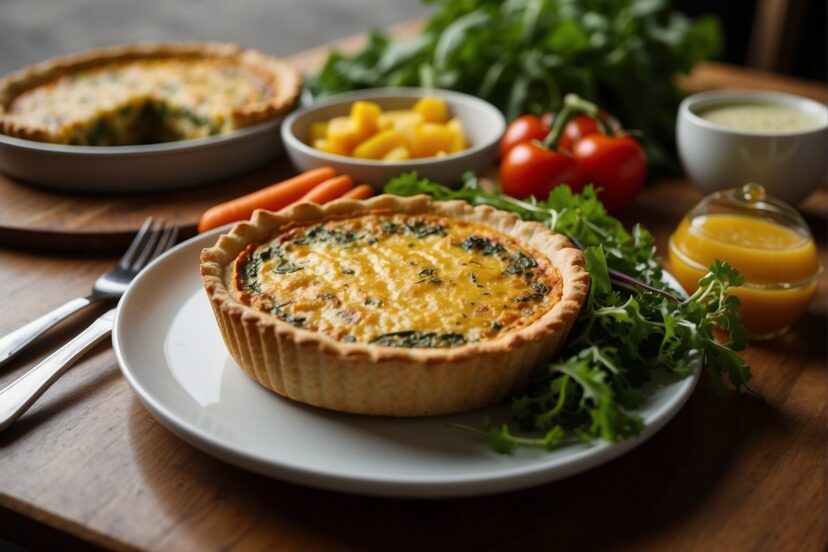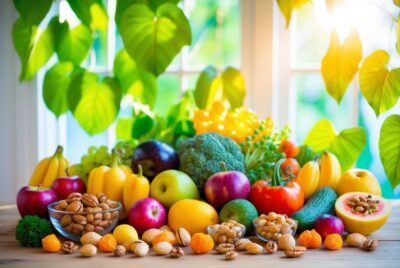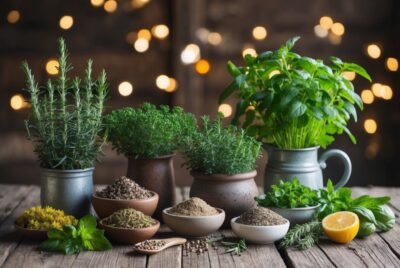Vegetarian Quiche: A Savory Guide to Eggless Delights
*We may earn a commission for purchases made using our links. Please see our disclosure to learn more.
Vegetarian Quiche: A Savory Guide to Eggless Delights
Vegetarian quiche is a versatile and savory staple that has earned its place as a beloved dish for any meal – be it breakfast, lunch, or dinner. As a vegetarian myself, I’ve come to appreciate the myriad of ways one can customize a quiche to fit personal tastes or to make use of available seasonal vegetables. The base of eggs and milk or cream enveloping a mixture of vegetables and cheese, all nestled in a buttery crust, allows for endless creativity. Whether opting for a classic combination like spinach and feta or something more adventurous, the ingredients blend into a symphony of flavors and textures, satisfying to both vegetarians and those simply looking for a meat-free meal.

My explorations have taught me that a successful vegetarian quiche starts with good quality ingredients. Selecting fresh vegetables such as zucchini, onions, mushrooms, and bell peppers not only provides better flavor but also contributes to the nutritional value of the dish. Cheese, another key component, can range from sharp cheddar for a bold taste to a milder mozzarella or a creamy goat cheese, depending on the desired outcome. I have learned that a well-made vegetarian quiche doesn’t just appeal to vegetarians but to anyone who loves good food.
One of the things I love about vegetarian quiche is its adaptability. For those with dietary restrictions, options like a gluten-free crust or a crustless quiche can make the dish accessible and enjoyable for a wider audience. And it’s not just about what you put into it – cooking techniques matter too. Understanding the right ratio of eggs to dairy, avoiding a soggy crust, and baking the quiche to golden perfection are just as important as the fillings. This is why I consider the vegetarian quiche not just a recipe but an art form that I enjoy cultivating and sharing.
Ingredients for a Vegetarian Quiche

Crafting the perfect vegetarian quiche begins with a selection of fresh vegetables, the right blend of cheeses, and a balance of eggs and dairy to bring it all together. The ingredients you choose are pivotal in creating a dish that’s both flavorful and satisfying.
Selecting Vegetables
Vegetable choice is crucial in a vegetarian quiche. I prefer a colorful array that not only enhances the visual appeal but also contributes an array of flavors and textures. Here’s a table of vegetables I incorporate:
| Vegetable | Notes |
|---|---|
| Onion | A base for flavor depth; can be caramelized or sautéed. |
| Mushrooms | Add earthiness; sauté to remove water and concentrate flavor. |
| Red Pepper | Brings sweetness and a vibrant pop of color. |
| Zucchini | Its mild taste integrates well; slice thinly to cook evenly. |
| Spinach | Rich in nutrients; wilt it to reduce volume and moisture. |
| Asparagus | Provides a tender-crisp texture; blanch or roast lightly. |
| Broccoli | Offers crunch; blanch to maintain color and lessen bitterness. |
| Cherry Tomatoes | Their juiciness complements drier veggies; halve and seed to reduce water. |
Choosing the Right Cheeses
The cheeses in a quiche not only lend creaminess but they’re the soul that ties the flavors together. I prefer a mix for complexity:
- Cheddar Cheese: Sharp and robust, adds a familiar tang.
- Swiss Cheese: Melts well, contributing a mild nuttiness.
- Feta Cheese: Crumbly texture and a salty kick enhance the other flavors.
- Gruyère: Creamy with a slight sweetness; it’s my go-to for a gourmet touch.
- Parmesan Cheese: I use a sprinkle for a salty, umami crust on top.
Combining cheeses like cheddar for sharpness with a smooth-melting Swiss or Gruyère balances taste and texture wonderfully.
Eggs and Dairy Options
Eggs are the binding agent in a quiche, creating the custard-like texture. I use:
- Fresh Eggs: The fresher, the better for a fluffy, light quiche.
- Whole Milk: It adds creaminess; for a richer quiche, a splash of heavy cream does wonders.
For lactose-intolerant or dairy-free preferences, silken tofu can be blended to replace the eggs and dairy, though keep in mind, this alters the traditional texture.
Creating the Perfect Quiche Base

In my experience, the foundation of a great vegetarian quiche lies in two essential components: a flaky, buttery crust and a smooth, creamy egg mixture. Master these, and you have the base for endless variations of this classic dish.
Crafting the Crust
Ingredients:
- 1 1/4 cups all-purpose flour (substitute with whole wheat or gluten-free if desired)
- 1/2 teaspoon salt
- 8 tablespoons unsalted butter, cold and cubed
- 4-6 tablespoons ice water
Instructions:
- I start with combining the flour and salt in a large bowl. I blend the cold butter into the dry ingredients using a pastry cutter or my fingers until the mixture resembles coarse crumbs.
- Gradually, I add ice water, one tablespoon at a time, and mix just until the dough comes together. Be careful not to overwork it.
- I shape the dough into a disk, wrap it in plastic, and chill for at least 1 hour.
- After chilling, I roll the dough out on a lightly floured surface and transfer it to a 9-inch pie plate.
- I make sure to trim any excess dough from the edges and crimp for a decorative touch.
- To prepare for blind baking, I line the crust with parchment paper, fill it with pie weights, and bake in a preheated 400°F (205°C) oven for about 15 minutes. Then, I remove the weights and paper and bake for an additional 5 minutes until the crust is golden brown.
Preparing the Egg Mixture
Ingredients:
- 4 large eggs
- 1 cup whole milk (or a combination of milk and heavy cream for richer taste)
- 1/4 teaspoon salt
- 1/4 teaspoon black pepper
- Pinch of nutmeg (optional)
Instructions:
- In a bowl, I whisk together the eggs, milk, salt, pepper, and nutmeg until thoroughly combined. The key here is to achieve a smooth mixture that will ensure an even and custardy texture once baked.
- If assembling an easy veggie quiche, I now layer my chosen vegetables into the pre-baked crust and then carefully pour the egg mixture over them. The egg mixture should just cover the veggies, ensuring they’re well-distributed.
Finally, I bake the quiche in the oven at 375°F (190°C) until the egg mixture is set and the top is lightly golden, usually about 35-45 minutes. The exact bake time depends on the depth and size of the dish. I always handcraft each element of my quiche with precision, ensuring a delightful result every time.
Cooking and Storing Tips for Vegetarian Quiche

When I bake a vegetarian quiche, I pay close attention to both the oven temperature and the texture of the quiche. Proper storage is crucial to maintain the quality and flavor when enjoying the leftovers.
Baking and Temperature Control
The key to a well-baked vegetarian quiche is temperature control. I always preheat my oven to the temperature specified in the vegetarian quiche recipe, typically around 350°F (175°C). It’s important to bake the quiche until the center is set but still slightly jiggly, which can take between 45 to 55 minutes depending on the specific recipe and oven. I always check the quiche by inserting a knife into the center to see if it comes out clean. Sautéing the vegetables in olive oil beforehand helps to release moisture and concentrate the flavors which avoids a soggy quiche.
- Preheat Oven: 350°F (175°C)
- Baking Time: 45-55 minutes
- Texture Check: Knife inserted in center comes out clean
Storing and Reheating Quiche
To store the vegetarian quiche, I let it cool completely to avoid condensation and then cover it tightly with plastic wrap or aluminum foil. It can be stored in the refrigerator for up to 3 days. For longer storage, I freeze the quiche by slicing it into individual portions and wrapping them securely. It can be frozen for up to 3 months.
Reheating the quiche properly ensures it retains its flavor and texture. I reheat slices in the oven at 350°F (175°C) until the center is warm, which typically takes about 20 minutes. If I’m in a hurry, I use a microwave, but I make sure to cover the slice with a microwave-safe lid to keep the moisture in and avoid rubbery eggs. For a frozen quiche, I defrost it in the refrigerator overnight before reheating.
- Refrigerator Storage: Up to 3 days
- Freezer Storage: Up to 3 months
- Reheat in Oven: 350°F (175°C) for 20 minutes
- Reheat in Microwave: Cover with a microwave-safe lid
Remember, when making the quiche ahead for a brunch, these baking and reheating tips will keep your vegetable quiche perfectly tender and tasty every time.
Serving Suggestions and Variations
In crafting the perfect vegetarian quiche, the variety of ingredients and serving options allows for a tailored experience whether it’s for breakfast, brunch, or a light dinner. I’ll guide you through fitting quiche into different meals as well as exploring alternative quiche styles including crustless variations and fusion flavors.
Quiche for Different Meals
Breakfast: For an easy breakfast, a cheesy broccoli quiche loaded with herbs is a hearty start. Serve with a side salad for added nutrition.
Lunch: A crustless quiche, like the one with caramelized onion and bell peppers, is a healthy, low-carb option. Add a light salad with a vinaigrette dressing for a complete meal.
Brunch: Mushroom quiche or a variation with leek is a classic French-inspired choice. Accompany with avocado slices for a creamy texture and a boost of healthy fats.
Dinner: Consider a Mediterranean quiche with feta, sun-dried tomatoes, and spinach. It’s a light dinner option when paired with a mixed greens salad.
Alternative Quiche Styles
Crustless Quiche: A crustless quiche is a superb low-carb alternative. Packing in vegetables like spinach and incorporating shredded cheese ensures a healthy and flavorful profile.
Elevated Variations: Adding onion, swapping in different cheeses, or introducing unexpected items like bacon (for those who eat meat) can elevate the traditional vegetarian quiche to a new level.
Fusion Flavors: Embrace fusion by incorporating Mediterranean ingredients such as olives and artichokes or go for a French twist with gruyère cheese and Dijon mustard.
Remember, the key to a successful quiche is balancing flavors and textures. Aim for a harmony of savory fillings and, if you prefer, a flaky crust to complement. Always keep nutrition information in mind to maintain a healthy profile for your meal.
Frequently Asked Questions

1. What are the essential ingredients for a classic vegetarian quiche?
The key ingredients for a classic vegetarian quiche include all-purpose flour, butter, and eggs. For the filling, a blend of milk or cream with cheese provides a rich base, while vegetables and herbs add flavor and nutrition.
2. Can you substitute milk for heavy cream in a vegetarian quiche, and what effect does it have?
Yes, you can substitute milk for heavy cream to lower the fat content, which will result in a lighter, less rich quiche. The texture might be less creamy, but it’s a suitable substitute for those looking for a healthier option.
3. What is the best way to prepare vegetables for inclusion in a quiche?
I recommend sautéing vegetables before adding them to a quiche. This enhances their flavor, removes excess moisture, and ensures they are partially cooked, as the baking time may not be sufficient to soften raw vegetables.
4. How does a vegetarian quiche Lorraine differ from the traditional recipe?
A vegetarian quiche Lorraine substitutes the classic bacon or lardons with vegetarian alternatives such as smoked tofu or tempeh to mimic the smoky flavor while keeping the dish meat-free.
5. What are some creative vegetarian fillings for a quiche?
Creative vegetarian fillings for a quiche include sun-dried tomatoes, spinach, feta cheese, asparagus, mushrooms, and various cheeses like Gruyère or fontina. Nuts and seeds can add a nice crunch, too.




